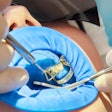
Dental lasers can significantly reduce the time it takes to complete a root canal procedure and other treatments compared to traditional high-and slow-speed handpieces. They are minimally invasive, which can leave the patient with better results and faster recovery times due to their advanced technology.
1. Lasers can reduce the risk of pain.
 Dr. Ben Curtis
Dr. Ben CurtisDental lasers have the ability to preserve the natural tooth and gently remove the decayed structure. This differs from handpieces and burs that can strip the natural tooth, causing pain.
Dental lasers reduce this risk by involving minimal contact with the tooth, ultimately reinventing restorative dentistry compared to conventional handpieces. With the goal of "no shot, no pain," we're delighted to shift away from traditional methods.
A dental laser can reduce the pain that many patients experience during treatment for a number of different reasons. For example, caries control can be performed without the need for local anesthesia when using a dental laser versus performing the procedure with a conventional handpiece, which can cause discomfort.
2. Lasers can reduce the need for local anesthesia.
Dental lasers allow for clean preparation, seamless procedures, and beautiful results -- in some cases, without the need for anesthesia. In contrast to dental handpieces, which can make teeth sensitive, dental lasers use water and allow for precision in procedures and treatments.
The dental lasers I've adopted in my practice allow me to reduce the need to administer local anesthesia. My staff is able to set the laser to the proper setting for each procedure, allowing us to tailor the treatment to each patient.
The laser can even eliminate the need to administer anesthesia by allowing for the incremental removal of tooth structure, reducing the pressure and even pain from using a bur. With dental lasers, caries can be removed without even touching the surrounding tooth.
3. Lasers can reduce recovery times.
My practice specifically adopted dental lasers with our pediatric patients in mind. In addition to using the technology for caries control and the management of cysts, we treat newborns needing frenectomies.
I've treated numerous cases where new parents were spending hundreds of dollars trying to determine the cause for their baby's inability to latch, not to mention losing countless hours of sleep from stress and their baby's distress. However, a dental laser can sometimes treat this concern in less than five minutes! Dental lasers eliminate the scalpel and need for sutures with an easy and reduced recovery time, delighting the parent and patient.
I also use the laser on children who have sustained soft-tissue trauma and developed mucoceles, cysts of mucus that persist. In procedures of this magnitude, traditionally, patients would have the area resected with a scalpel and require sutures. However, dental lasers eliminate the scalpel and need for sutures with an easy and reduced recovery time.
Dr. Ben Curtis is director of the Waterlase Pediatric Academy from Biolase. He attended Baylor College of Dentistry and completed his pediatric specialty residence at Children's Medical Center Dallas, Texas Scottish Rite Hospital for Children, and Baylor College of Dentistry. Curtis is a diplomate of the American Board of Pediatric Dentistry. He is passionate about children's advocacy at the local, state, and national level.
The comments and observations expressed herein do not necessarily reflect the opinions of DrBicuspid.com, nor should they be construed as an endorsement or admonishment of any particular idea, vendor, or organization.



















